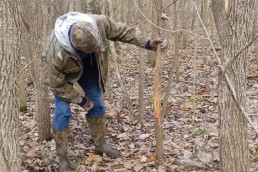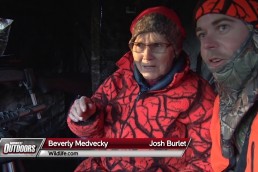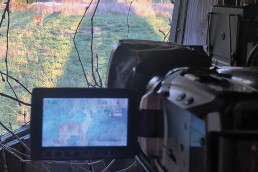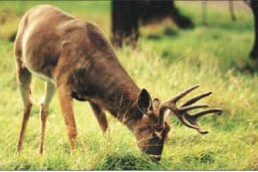Get Out and Scout Right Now for Next Deer Season
SHARE THIS POST
Deer season is over and many hunters are singing the blues as they have months to wait until deer season returns. Hopefully, this past season was a success for you. But now is the time to get a jump on next season’s hunt by scouting. Get out and scout to see what the deer have been up to.
Scouting for deer now is much less disturbing to the deer than waiting until the season is about to begin. And if you do happen to spook deer they have plenty of time to forget about you in the coming months.
This is particularly true when trying to pattern a big buck. Walking through the bedding grounds of a mature white-tailed buck just weeks before season begins will all but guarantee you won’t see that buck while hunting. If the area has a lot of pressure, big bucks will only take so much human intrusion before they find somewhere else to hang out.
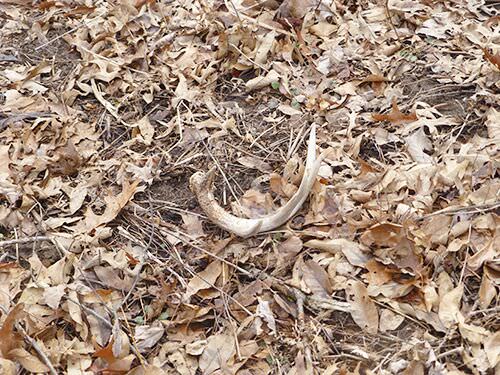
It is easier now to locate trails deer often use to get from feeding to bedding grounds—no matter how dense the area might be. These trails could change as the food sources change in the summer, but the trails they use to leave their bedding grounds will not differ. Eventually, these pathways to food sources will come back around to its “fall” patterns too. And, hanging stands near bedding areas now will yield more chances at bucks when the season opens rather than hanging stands over food sources.
The trails are more visible now, as well as the buck rubs. Bucks leave good sign behind as they polish their antlers and get in some practice fights with small saplings. A rub tells a lot about the bucks in the area and their routine. Rubs are the one time where size does matter. The bigger the diameter of the tree the rub is on, the bigger the buck that made that rub. Big bucks will rub small trees, but small bucks do not rub big trees. When you find a tree at least 6 inches in diameter, you can be sure a mature buck made that rub.
Bucks are known to rub trees in the same area from one year to the next. Hunters who know where rubs were located in previous seasons can use this to their advantage—as long as the buck that made the rub is still alive. Hang a stand before rubs start appearing to ambush a buck as he comes to renew his rub line. By learning to interpret rubs, hunters will be able to tell where bucks are eating and sleeping. If the shiny side of a rub is facing a dense thicket, this is more than likely where the bucks are breeding. If the shiny side of the rub is facing a food plot, clover field or other food source, this is probably where they spend the night eating. Make your setup and hunt accordingly.
Scrapes can appear magically overnight. One element of a good scrape location is a good “licking” branch hanging over the scrape. Scrapes are often found along logging roads, ridgelines and edges of swamps, creeks and riverbeds.
Are you enjoying this post?
You can be among the first to get the latest info on where to go, what to use and how to use it!
Chances are that if you locate scrapes or a scrape line now from the previous season, new ones will be constructed very near the same area the following season.
Once you locate good locations for a stand or ground blind, winter is the best time to get them in place. Bucks will notice anything “out of place,” and a new stand or blind is certainly that. Making these changes now to their landscape will give the deer plenty of time to grow accustomed to them.
Preparing shooting lanes is also something that should be done now, and will give deer plenty of time to get use to the alternations to their cover. Creating shooting lanes is not something only archers should be concerned with. There has been multiple times when I have not had a shot opportunity with my firearm because he was in too thick of cover—even though the deer was very close. Remember, the smallest twig can send a slug places other than where you want it.
Also, look for shed antlers now. Finding sheds will give you a good idea of what deer survived the season as well as the winter. Not only is it a good scouting tool, but also fun.
Winter is the best time to find clues left behind by deer so you can pattern their movements in actual hunting times, and not during their summer patterns. It is also a great time to check out new ground you have never hunted before. So get out and do some scouting now, when the time is right.
MWO
SHARE THIS POST
Did you enjoy this post?
You can be among the first to get the latest info on where to go, what to use and how to use it!
Jason Houser
Jason Houser is an avid outdoorsman from Central Illinois. Houser has been a full-time freelance writer since 2008. He is also the host of Jason Houser Outdoors, airing on the Hunt Channel. He can be found on Facebook at Jason Houser Outdoors or on the web at jasonhouseroutdoors.com.
